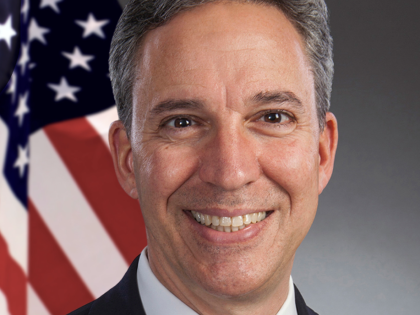
Senator Martins Tackles Full Plate of Issues
From the Floral Park Dispatch, an Anton Community Newspaper
By Melissa Argueta
As the second month of his first term arrived, Senator Jack M. Martins of the 7th Senatorial District sauntered into a room of reporters, appearing ready to answer just about any question there was to ask. During the senator’s first roundtable, Martins, the former mayor of Mineola, provided clarification and insight on local and state issues, including Governor Cuomo’s proposed 2011-12 Executive Budget, the state Senate’s recently passed 2 percent property tax cap, as well as the importance of job creation and revitalization of downtowns to spurt growth of Long Island’s struggling economy.
On Feb. 1, Governor Andrew M. Cuomo unveiled a proposed 2011-2012 Executive Budget that he touts will achieve “real, year-to-year savings while restructuring the way state government is managed.”
Martins reacted to the content of the governor’s budget, noting it was much of what he had expected. “It was certainly consistent with what the governor had said he was going to do. He campaigned all along on a sense of fiscal responsibility and cutting as opposed to raising fees and taxes and the budget reflects that,” Martins said.
Martins maintained that there are still questions to be answered on the allocation of resources in the budget, particularly when it comes Medicaid. “It’s a zero sum game. You only have a certain amount of money that you can project you are going to have for the year. I would have liked to have seen the governor take a more holistic approach when it came to it, certainly, taking as much away from education year to year was disappointing,” he said.
A point of contention for Martins was that the budget called for a reduction in school aid more severe than the reduction in Medicaid. Following years of unsustainable growth, the Executive Budget reflects a year-to-year All Funds decrease of nearly $1 billion ($982 million), or two percent, in Medicaid spending in 2011-12. Gap closing actions totaling $2.85 billion for 2011-12 will be advanced by the Medicaid Redesign Team.
Education in New York is financed primarily through a combination of state and local funding. Under current law, school aid was slated to grow at a rate of 13 percent in 2011-12. The Executive Budget proposes school aid of $19.4 billion for the 2011-12 school year, a year-to-year reduction of $1.5 billion. This represents a reduction of 2.9 percent of the total operating expenditures projected to be made by school districts statewide during the 2010-11 school year, and 7.3 percent in state support. After these reductions, which represent $2.85 billion, school aid will continue to represent the largest state-supported program, accounting for 29 percent of General Fund spending.
“If you look at the year-to-year numbers, the budget, on the school side year to year, goes down approximately $1.5 billion, but on the Medicaid side it goes down $1 billion. I would think that there is more of an opportunity to streamline Medicaid and eligibility than there is to attack school funding, especially at a time when the governor’s also, as is the legislature, advocating for a 2 percent tax cap. Certainly, to relieve some pressure on our local school districts, it’s important that we understand that they can’t bear the lion’s share of the brunt of state cuts,” Martins said.
On the first day of the month, Martins voted, along with a bipartisan majority of the Senate, to pass a 2 percent tax cap on property taxes. The legislation, supported by Governor Cuomo, caps the growth of school and local municipality tax levy increase at 2 percent or the Consumer Price Index (CPI), whichever is less. As of now, the bill is waiting to be debated in the Assembly, according to Martins.
The New York Conference of Mayors (NYCOM) formed a task force to create a series of recommendations for property tax and mandate relief prior to implementing a tax cap in December 2010. Martins agreed that along with a tax cap, there is a need for mandate relief not only for local governments, but for counties, town and villages, as well.
“We’re aware that pension costs are going up significantly, year to year, in many instances beyond that 2 percent tax levy. We look at health care costs and where they’re going… there is a sense that we have to do something to reel in those costs so that we have the opportunity to allow local governments to continue to provide the services that they provide within that 2 percent cap,” Martins said.
He further stated that if local governments, including school districts, didn’t have the state imposed requirements and were simply administering their own local expenses such as parks, sanitation and fire, they would be able to live within their 2 percent cap. Martins reiterated that the next step, and it’s lock step with the 2 percent cap, is providing relief for the mandates. He stated the governor has recently appointed a number of task forces and there will also be hearings by various committees in the legislature dealing with mandate relief.
With more than 103,000 Long Islanders currently unemployed and small businesses seeking economic recovery, Martins joined four other state senators to announce the passing of the Job Creation and Taxpayer Protection Act of 2011 at the end of January. The act contains a three-part plan to encourage the creation of new private sector jobs and ensure fiscal responsibility.
Martins explained that stimulating job growth is encouraged through giving tax incentives to local employers. “If we can give employers an incentive to hire people by defraying the cost of their employment, then I think that it’s important that we do so,” he said.
“Ultimately, it’s a zero cost to us because if the person was not employed, they wouldn’t be paying it anyway and we’d probably be paying some sort of unemployment benefit. By virtue of the fact that we take people off unemployment and we put them to work and give the employers a write-off against that, the person who is still working is still paying taxes on that money anyway,” Martins added.
When questioned on the newly implemented regional economic development councils that the governor has set up to address each region in the state differently, Martins agreed with the governor’s approach. “It’s an interesting way of handling the different needs of the different areas in the state. We are one state, but we have different pressures in different areas,” Martins said.
“Nassau County has $1.3 million people. You’ve got counties in upstate New York that have 20,000, 30,000 people. When you begin to contextualize the differences between not only density, demographics and economies and so to put one statewide approach to stimulating the economy in different regions, statewide doesn’t make sense, so you break it down into regions,” he said.
For Long Island regions of Nassau and Suffolk counties, Martins hopes this new approach is going to resolve problems such as the imminent need for affordable housing and the need to revitalize downtowns as a means of spurring the economy, not only short-term jobs but long-term jobs. He also said there is a need to keep young adults and senior citizens living in the community.
According to Martins, nothing has been done in a regional way to address these issues and set the tone for the next 50 years. He emphasized that the new Levittown housing model may need to include increased density around train stations, with a component for rental and affordable or next generation housing around transportation hubs and revitalizing our downtowns as a result.
If you ask young people today coming out of school, where they want to live, Martins said many of them want to live in the downtown. “As they retire and move on, they want to necessarily stay in their communities but they might not be continue to be able afford it or maintain their homes, so they want to move into a place, again, in their communities, that’s more affordable. So we have the opportunity to address that,” he said.
A key area that would benefit from revitalization is Belmont Park, which borders the Elmont and Floral Park communities. Martins said he is a part of an upcoming Racing and Wagering Committee hearing to discuss the future of racing in New York State. “Belmont is an important part of our district, certainly, as an economic engine. It is an important part of future plans not only for the local communities immediately adjoining Belmont, but also for Nassau County. It is a tremendous facility with really incredible potential and has a stop on the Long Island Rail Road directly from the city,” Martins said.
Martins also stressed that there must be a balance between helping the community and not adding to the additional traffic that residents may not want. “There are real opportunities there to try and promote it and integrate it into the local communities and try and use it as a means of spurring some economic development,” he said.
Racing attractions such as Belmont Park offer an untapped financial component on a state and local level, according to Martins. “There should be more of an economic opportunity to the residents and taxpayers of Nassau County coming from a facility like Belmont than there is. So we’ll be watching,” he said.



